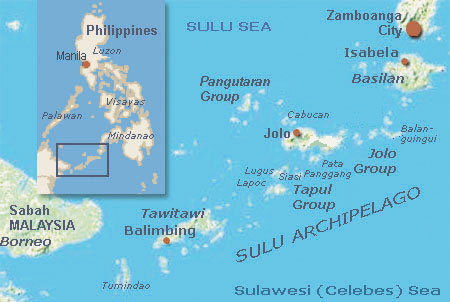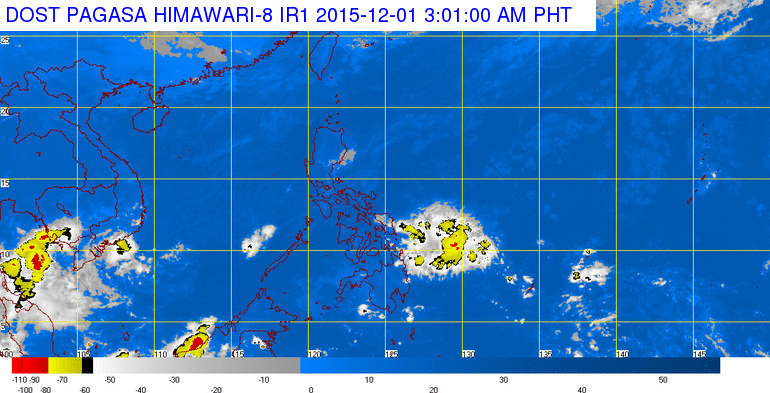The Sulu equation
by Apple Santiago Oreta

Sulu has acquired a shady image in the eyes of outsiders. “Be careful” was the common remark I get when friends learned that I was going there.
As soon as the plane landed in the airstrip that looked battered by time and neglected by modernization, we were welcomed by our host accompanied by a security detail. “That’s S.O.P (standard operating procedure) here especially if you’re an outsider” was his explanation. And the guard did not at all look stealthy -- he was in security uniform and had with him an M-16. But his long arm was not what caught my attention -- it was the number of uniformed, armed military men waiting for, obviously, a VIP. I soon learned that the Governor was among the plane passengers, along with some Manila-based well-jeweled visitors. The military was making sure that the Governor got home safe, and the visitors get to do their business without a glitch.
As we traverse the road in Jolo, the capital of Sulu, the scene I saw was all too familiar -- people were going about their daily, everyday routine of finding a living; the town looked like any of the towns I’ve visited. Sure, there were more patrol vans with police in fatigue uniforms with their long firearms, but other than that, the town looked ordinary. I wondered aloud -- “it looks safe, why do outsiders think it’s violent here?”
“The real test of safety is when the local government officials can walk around town without their bodyguards,” my host lectured. I learned that several attempts of assassination had been carried out against local officials.
I was in Jolo for a workshop with researchers; the main goal was to understand the conflict dynamics and how people mitigated violence in selected barangays in Sulu. Six cases were selected, each with varying levels of conflict.
“The basic issue in this barangay is family feud due to land conflict. In the next barangay, the land dispute is complicated by political contestation.” The six cases have almost similar themes -- family feud over land ownership carried over through generations, complicated by the wide proliferation of firearms, and spilling over into political contests. The barangay captain position becomes hotly contested due to its control of the IRA (internal revenue allocation) as well as other goods and resources in the community. The barangay is the tier of government that is most relevant to the people, and the unit that receives the government’s IRA intended for, supposedly, community development. In barangays where the officials are involved, they sometimes sustain the conflict, the IRA remains with the barangay captain, and the people suffer a triple whammy -- a prolonged conflict, no IRA being used for community development, but instead used to secure more guns and sustain the armed groups involved in the conflict.
These conflict-ridden communities are the most difficult to reach and hence very limited local government services are poured in. People in these communities are trapped not just in violence, but more insidiously, trapped in the mindset that they need to take sides between the two warring factions. The sad part is, most often, these warring groups are part of the same, extended family clan.
It is in these communities where lawless groups proliferate, get support, and get recruits as the seeming hopelessness of the situation leaves people with no option. The cycle of violence, victimization, and radicalization of dissent is carried over for generations.
But there are silver linings also. Some communities have initiated a consensus-building process where covenants are signed and sworn-in by conflicting clans. Relative peace is enjoyed by these communities and manifestations of respite are palpable: ordinances banning public display of firearms are observed; close collaboration between the barangay and the village elders is reestablished; schools operate; and local government services begin to flow in. Lawless groups cannot recruit in these communities as the people themselves dissuade them from entering their village. It was indeed heartwarming to listen to these inspiring examples. Although I also know that this relative peace cannot hold if the other barangays remain enmeshed in violence; the spilling-over effect of violence from one place to another has been proven historically. Nevertheless, I prayed that perhaps this time around, it is the relative-peace enjoyed by the people that would spill over in conflict-ridden barangays.
“Sulu used to be rich. In the ’70s and ’80s, traders from Manila come here to get imported goods -- legally -- to be sold in Manila,” said one government official. It is the insecurity over land, complicated by greed for money, power, and position by political players that have brought Sulu to its knees.
As the boat leaves the island, I looked back and marvel at the untouched shores of Patikul. The placidness of the scene saddens me -- just a few weeks ago, a bridge that connected Patikul with the other Barangays was bombed. I whispered a short prayer for the people, and wondered how Sulu can again regain its glory.
**********
 The author is the convener of the ADMU Political Science Department-Working Group on Security Sector Reform (WG-SSR), a group of faculty, staff, and students involved in research and projects on SSR. Comments are welcome appleoreta@gmail.com
The author is the convener of the ADMU Political Science Department-Working Group on Security Sector Reform (WG-SSR), a group of faculty, staff, and students involved in research and projects on SSR. Comments are welcome appleoreta@gmail.com
As the plane approaches the island, one word entered my mind: magnificent. Trees peppered the isle, accented with pockets of inlet bodies of water that when viewed from above look like mini swimming pools surrounded by trees. God must have been inspired when the island of Sulu was created. If nature had a contest, I’m sure Sulu would easily quality as among the top contenders. It’s such a pity that such beauty hides a dark and sinister reality.

Sulu has acquired a shady image in the eyes of outsiders. “Be careful” was the common remark I get when friends learned that I was going there.
As soon as the plane landed in the airstrip that looked battered by time and neglected by modernization, we were welcomed by our host accompanied by a security detail. “That’s S.O.P (standard operating procedure) here especially if you’re an outsider” was his explanation. And the guard did not at all look stealthy -- he was in security uniform and had with him an M-16. But his long arm was not what caught my attention -- it was the number of uniformed, armed military men waiting for, obviously, a VIP. I soon learned that the Governor was among the plane passengers, along with some Manila-based well-jeweled visitors. The military was making sure that the Governor got home safe, and the visitors get to do their business without a glitch.
As we traverse the road in Jolo, the capital of Sulu, the scene I saw was all too familiar -- people were going about their daily, everyday routine of finding a living; the town looked like any of the towns I’ve visited. Sure, there were more patrol vans with police in fatigue uniforms with their long firearms, but other than that, the town looked ordinary. I wondered aloud -- “it looks safe, why do outsiders think it’s violent here?”
“The real test of safety is when the local government officials can walk around town without their bodyguards,” my host lectured. I learned that several attempts of assassination had been carried out against local officials.
I was in Jolo for a workshop with researchers; the main goal was to understand the conflict dynamics and how people mitigated violence in selected barangays in Sulu. Six cases were selected, each with varying levels of conflict.
“The basic issue in this barangay is family feud due to land conflict. In the next barangay, the land dispute is complicated by political contestation.” The six cases have almost similar themes -- family feud over land ownership carried over through generations, complicated by the wide proliferation of firearms, and spilling over into political contests. The barangay captain position becomes hotly contested due to its control of the IRA (internal revenue allocation) as well as other goods and resources in the community. The barangay is the tier of government that is most relevant to the people, and the unit that receives the government’s IRA intended for, supposedly, community development. In barangays where the officials are involved, they sometimes sustain the conflict, the IRA remains with the barangay captain, and the people suffer a triple whammy -- a prolonged conflict, no IRA being used for community development, but instead used to secure more guns and sustain the armed groups involved in the conflict.
These conflict-ridden communities are the most difficult to reach and hence very limited local government services are poured in. People in these communities are trapped not just in violence, but more insidiously, trapped in the mindset that they need to take sides between the two warring factions. The sad part is, most often, these warring groups are part of the same, extended family clan.
It is in these communities where lawless groups proliferate, get support, and get recruits as the seeming hopelessness of the situation leaves people with no option. The cycle of violence, victimization, and radicalization of dissent is carried over for generations.
But there are silver linings also. Some communities have initiated a consensus-building process where covenants are signed and sworn-in by conflicting clans. Relative peace is enjoyed by these communities and manifestations of respite are palpable: ordinances banning public display of firearms are observed; close collaboration between the barangay and the village elders is reestablished; schools operate; and local government services begin to flow in. Lawless groups cannot recruit in these communities as the people themselves dissuade them from entering their village. It was indeed heartwarming to listen to these inspiring examples. Although I also know that this relative peace cannot hold if the other barangays remain enmeshed in violence; the spilling-over effect of violence from one place to another has been proven historically. Nevertheless, I prayed that perhaps this time around, it is the relative-peace enjoyed by the people that would spill over in conflict-ridden barangays.
“Sulu used to be rich. In the ’70s and ’80s, traders from Manila come here to get imported goods -- legally -- to be sold in Manila,” said one government official. It is the insecurity over land, complicated by greed for money, power, and position by political players that have brought Sulu to its knees.
As the boat leaves the island, I looked back and marvel at the untouched shores of Patikul. The placidness of the scene saddens me -- just a few weeks ago, a bridge that connected Patikul with the other Barangays was bombed. I whispered a short prayer for the people, and wondered how Sulu can again regain its glory.
**********
 The author is the convener of the ADMU Political Science Department-Working Group on Security Sector Reform (WG-SSR), a group of faculty, staff, and students involved in research and projects on SSR. Comments are welcome appleoreta@gmail.com
The author is the convener of the ADMU Political Science Department-Working Group on Security Sector Reform (WG-SSR), a group of faculty, staff, and students involved in research and projects on SSR. Comments are welcome appleoreta@gmail.com








Post a Comment